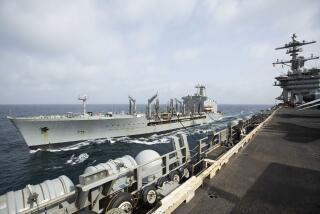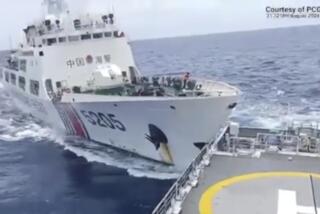Navy orders ‘operational pause’ for warships and a fleet-wide investigation after latest collision at sea

The collision led to flooding in some crew berths, as well as in the machinery and communications rooms. (Aug. 22, 2017)
Reporting from AMMAN, Jordan — The Navy said Monday that the world’s largest and most powerful armada will immediately pause operations for a fleet-wide safety review following the pre-dawn collision of a guided-missile destroyer and an oil tanker that left 10 sailors missing near Singapore, the fourth naval accident in the Pacific this year.
Chief of Naval Operations Adm. John Richardson announced the rare “operational pause” in a video posted to social media Monday. He did not say how long it would last.
He also ordered a comprehensive review into causes of the recent accidents, saying “more forceful action” is needed to determine why trained crews on U.S. warships carrying radars and other high-tech sensors failed to avoid collisions while underway.
“I have directed fleet commanders to immediately conduct an operational pause with commands and leaders across the fleet, to ensure we are taking all appropriate immediate measures to enhance the Navy’s safe and effective operation around the world,” Richardson said.
The orders come as tensions with North Korea again notched upward. Thousands of U.S. and South Korean troops began 10 days of joint drills Monday, and Pyongyang warned it could lead “into the uncontrollable phase of a nuclear war.” U.S. warships in the western Pacific are critical to South Korea’s defense.
The fleet-wide stand-down was announced hours after the U.S. guided-missile destroyer John S. McCain collided with the Alnic MC, a Liberian-flagged oil and chemical tanker that is nearly three times its size. The accident occurred at 5:24 a.m. local time at the entrance to the Strait of Malacca, one of the world’s busiest shipping lanes.
Ten sailors are missing and presumed dead and five sailors were injured after water flooded into a huge gash in the McCain’s port hull, flooding crew berthing, machinery, and communications rooms, the Navy said.
Defense Secretary James N. Mattis told reporters traveling with him in Jordan on Monday that he has sent condolences to families of the missing sailors.
“My thoughts and prayers are with the sailors and families of the USS John McCain,” he said. “We obviously have an investigation underway, and that will determine what happened.”
Despite the extensive damage, the hobbled destroyer arrived at Changi Naval Base in Singapore under its own power. Search-and-rescue operations were underway using Navy Seahawk helicopters and Ospreys as well as Singaporean tugboats, Navy and coast guard vessels.
The Strait of Malacca is one of the world’s most congested shipping lanes. Much of Asia’s oil imports traverse the choke point on the way to the South China Sea, where China is building artificial islands in waters that its neighbors also claim.
The cases highlight the geopolitical tensions at play in the region. Earlier this month, China’s Foreign Ministry denounced the United States after the McCain passed close by an island in the South China Sea that China claims.
The state-run China Daily used the accident to note “the way U.S. warships tend to sail without observing maritime traffic rules and the sloppiness of their crews.”
The bow of the Alnic was damaged but no crew members were injured, according to Singapore’s Maritime and Port Authority.
The McCain is one of 14 U.S. warships based in Japan that are equipped with the Aegis cruise missile defense system. The vessels are seen as critical to defending against a North Korean missile launch.
Richardson said the comprehensive review will include “operational tempo, performance, maintenance, equipment and personnel.” It will be on a “tight timeline” and also look into “tactical and navigational proficiency” of sailors, he said.
Adm. Phil Davidson, the commander of U.S. Fleet Forces Command, will lead the review.
The latest collision comes two months after the McCain’s sister ship, the guided-missile destroyer Fitzgerald, was rammed by a much larger Philippine-flagged container ship, the ACX Crystal, on a calm, clear night about 50 nautical miles from the Japanese port of Yokosuka.
Seven sailors were killed in the June 17 collision, and the commander and his executive officer were relieved of command last week after a Navy investigation.
A guided-missile cruiser, Lake Champlain, collided with a South Korean fishing vessel on May 9 off the Korean Peninsula. Another guided-missile cruiser, Antietam, ran aground Jan. 31 and gushed oil into Tokyo Bay.
All of the U.S. ships are part of the Navy’s 7th Fleet based in Yokosuka, Japan.
The McCain, a 505-foot-long Arleigh Burke-class destroyer, was heading to Singapore on a routine port visit after patrolling in the South China Sea.
The most recent photos on the McCain’s Facebook page show the crew playing cards, chatting and fishing off the deck at sunset Saturday during a “patrol in the South China Sea in support of security and stability in the Indo-Asia-Pacific region.”
The Alnic, which stretches 600 feet, also was sailing toward Singapore when the accident occurred. It is more than three times the size of the McCain, with a gross tonnage of 30,000 compared with the destroyer’s 8,300.
When asked by reporters about the collision late Sunday night, President Trump initially said, “That’s too bad.” He later tweeted “thoughts & prayers” for the sailors aboard the ship.
The McCain, nicknamed “Big Bad John,” is named for the father and grandfather of Sen. John McCain (R-Ariz). Both served as admirals in the Navy during World War II.
“Cindy & I are keeping America’s sailors aboard the USS John S McCain in our prayers tonight,” the Arizona Republican wrote on Twitter.
Twitter: @wjhenn
ALSO:
U.S. special operations forces face growing demands and increased risks
The U.S. is launching ‘danger-close’ drone strikes so risky they require Syrian militia approval
More to Read
Sign up for Essential California
The most important California stories and recommendations in your inbox every morning.
You may occasionally receive promotional content from the Los Angeles Times.











